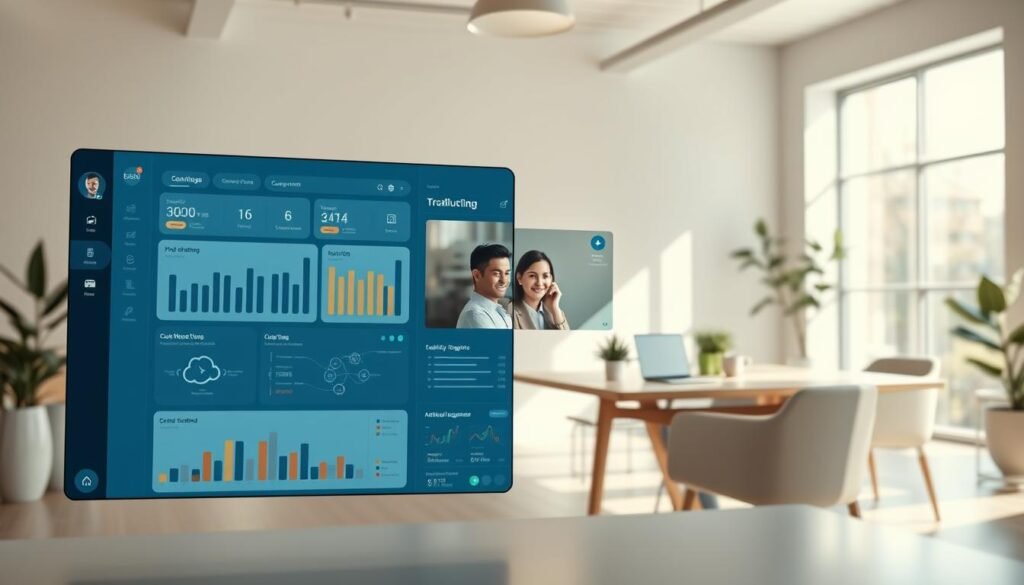In today’s work environments, cutting-edge technologies play a big role. They help increase productivity and teamwork. We look at how IT development makes work better with new remote work IT solutions and hybrid workplace software.
At Consac, we think transformative learning is essential. It helps workplaces reach their best. By using innovative IT solutions, companies can work more efficiently. For more details, reach out to us at info@consac.dev.
Understanding Remote Work IT Solutions

Remote work is becoming more common, and IT solutions play a key role. Distributed teams need effective IT solutions to work well together.
Definition of Remote Work IT Solutions
Remote work IT solutions include many technologies and tools. They help teams work together, stay productive, and communicate easily. These tools are remote work software, IT productivity tools, and remote work platforms.
At its core, these solutions provide the needed infrastructure for remote work. They include tools for virtual meetings, managing projects, and real-time communication. These are vital for keeping teams productive and working together well.
Key Features to Look For
When choosing remote work IT solutions, look for a few key features. First, the solution should be user-friendly and intuitive. This means it should be easy for team members to learn and use.
It’s also important that the solution is scalable. It should be able to grow with the team’s needs. Other key features include robust security measures to protect data, reliable customer support, and seamless integration with other tools and systems.
Experts say, “The right IT solutions are key to remote work success.” Knowing what to look for in remote work IT solutions helps organizations make good choices for their remote work strategies.
“The future of work is not just about technology; it’s about creating a culture that thrives in a remote environment.”
The Rise of Hybrid Workplaces

Hybrid workplaces are becoming more common. They mix the perks of working from home with the teamwork of offices. It’s key to know what a hybrid workplace is and how to make it work with the right tools.
Defining the Hybrid Workplace
A hybrid workplace has both remote and in-office workers. It offers flexibility and uses the best of both worlds. Employees can work from home, a coffee shop, or the office, making the workforce more adaptable and strong.
To make a hybrid workplace work, companies need hybrid workplace software. This software helps with communication and teamwork, no matter where people are. It includes tools for virtual meetings, managing projects, and talking in real-time.
Benefits of Hybrid Work Models
The hybrid work model has many advantages, such as:
- More flexibility and balance between work and life for employees
- More productivity because of less time commuting and fewer distractions
- Access to more talent, as location is less of a barrier
- Better teamwork and creativity with virtual collaboration tools
- Lower costs for companies, like less money spent on office space
To get the most out of these benefits, businesses should use digital workspace solutions. These solutions help a team work well, no matter where they are. They make sure everyone has what they need to stay connected and productive.
By going for the hybrid workplace model and using the right tech, companies can make their work environment better. For more details on setting up hybrid workplace solutions, contact us at info@consac.dev.
Essential Hybrid Workplace Software

Hybrid workplaces need software to help teams work together, manage projects, and talk easily. Finding the right tools is key to boosting productivity and teamwork.
Collaboration Tools
Collaboration is vital in any team, even more so in hybrid workplaces. Slack and Microsoft Teams let teams work together in real-time. They share files and work with other apps.
These tools make sure everyone, whether at home or in the office, is in sync.
Look for these features in collaboration tools:
- Real-time messaging and file sharing
- Integration with project management software
- Video conferencing capabilities
Project Management Solutions
Hybrid workplaces need tools to track progress, assign tasks, and work together. Trello, Asana, and Jira are great for this. They keep teams organized, on time, and flexible.
When picking project management software, think about:
- Task assignment and tracking
- Gantt charts or calendar views for project timelines
- Integration with collaboration and communication tools
Communication Platforms
Good communication is essential in hybrid workplaces. Zoom and Google Meet are key for virtual meetings. Email and instant messaging apps help team members talk well.
It’s also important to have a plan for remote IT support services to fix tech problems fast.
Consider these when choosing communication platforms:
- Reliability and quality of video and audio
- Ease of use and accessibility
- Integration with calendar apps for scheduling meetings
Using these software solutions helps businesses create a great hybrid work space. It supports remote workforce management and IT automation software use. For more tips on hybrid workplaces, contact us at info@consac.dev.
The Role of IT Productivity Tools
Remote and hybrid work models are becoming more common. IT productivity tools play a key role in making work easier. They help us do tasks faster, work together better, and be more efficient.
We use many IT productivity tools to get our work done well. These tools fall into different categories, each with its own purpose.
Types of IT Productivity Tools
IT productivity tools include a variety of software. Here are some examples:
- Project management software
- Time tracking and monitoring tools
- Collaboration and communication platforms
- Document management systems
These tools help us manage our work, track progress, and talk to our team easily.
Tracking and Monitoring Tools
Tracking and monitoring tools are key for better workflows and timely projects. Some top tools include:
| Tool | Description | Key Features |
|---|---|---|
| Toggl | Time tracking software | Simple time tracking, automated reports |
| RescueTime | Productivity tracking software | Automatic time tracking, detailed reports |
| Asana | Project management software | Task management, team collaboration |
These tools help us find ways to work better and make smart choices based on data.
Using these IT productivity tools can really boost our work efficiency. To learn more about using them, contact us at info@consac.dev.
Enhancing Team Collaboration

Teams working from different places need to work together well. The right tools and strategies are key to a productive team. This is true for remote and hybrid teams.
Virtual Meeting Software
Virtual meeting software is a must for remote teams. Tools like Zoom and Google Meet let teams meet face-to-face from anywhere. They have features like screen sharing and recording to make meetings better.
When picking virtual meeting software, look at video quality and ease of use. Zoom has plans for all team sizes. Google Meet works well with Google Workspace.
Shared Document Platforms
Shared document platforms are important for teamwork. They let teams work on documents together in real-time. Google Drive and Microsoft OneDrive are popular for this.
These platforms help teams stay on the same page. They also keep important documents in one place. This reduces misunderstandings and keeps everyone updated.
Real-Time Communication Channels
Real-time communication channels are key for quick team talks. Slack and Microsoft Teams are top choices. They offer messaging, group chats, and file sharing.
Think about your team size and communication needs when choosing. Slack has many integrations. Microsoft Teams works well with Microsoft Office 365.
| Collaboration Tool | Key Features | Integration |
|---|---|---|
| Zoom | Video conferencing, screen sharing, recording | Google Calendar, Slack, Microsoft Outlook |
| Google Drive | Real-time document editing, commenting, version history | Google Workspace, Microsoft Office |
| Slack | Direct messaging, group chats, file sharing | Google Drive, Trello, Asana |
Using these tools can improve teamwork and productivity. Whether you’re remote or hybrid, the right tools keep you connected and help you reach your goals.
If you have questions or need help, contact us at info@consac.dev.
Security Considerations for Remote Work

Remote work is becoming more common, and keeping our digital world safe is key. With more people working from home, new security risks have appeared. Companies must now protect their data and keep work flowing smoothly.
Critical Aspects of Cybersecurity
Cybersecurity is more than just fighting off hackers. It’s also about making sure remote workers can safely use what they need. This means using strong security steps like multi-factor authentication and encryption to keep data safe.
Remote IT support services are vital for keeping things secure. They help companies watch over their IT systems from afar, tackle security problems fast, and help remote workers. Using IT automation software helps automate tasks, lowers the chance of mistakes, and boosts security.
Implementing Secure Access
To make access safe, companies should follow a few important steps. First, they should use a zero-trust security model. This model sees every user and device as a possible threat. It means always checking and watching to make sure only the right people get to important stuff.
Second, companies should get secure remote access technologies like VPNs and secure desktops. These tools let remote workers get to company resources safely. They also keep out unwanted visitors.
For more details or to talk about your security needs, get in touch at info@consac.dev.
Integrating Remote Work Technologies

Getting remote work technologies to work well depends on smooth integration and good training. When we bring in new tech, it’s key to make sure it fits into our work flow easily.
Steps for Effective Integration
To make remote work software and hybrid workplace tools work well, we need a clear plan. Here are the main steps:
- Assess Current Infrastructure: Check our current IT setup to find where new tech can fit and what might be tricky.
- Choose Compatible Tools: Pick tools that work well with what we already have.
- Develop an Integration Plan: Make a detailed plan for how to integrate, when, and who will do it.
- Test and Validate: Do lots of testing to make sure everything works as it should.
Training and Onboarding Strategies
Good training and onboarding are key to using remote work tech well. We need to create training that fits different learning styles and needs.
Some important strategies include:
- Blended Learning Approaches: Mix online training with live sessions for a full learning experience.
- Hands-on Training: Give practical training to help people get used to new tools and tech.
- Ongoing Support: Keep support going with help desks, FAQs, and regular check-ins to help with any issues.
By following these steps and strategies, we can make sure our remote work tech works well. And our teams will be ready to use these tools to boost productivity. For more info or to talk about your specific needs, please contact us at info@consac.dev.
Measuring Productivity in Remote Settings

Measuring productivity in remote settings is a complex task. It needs a careful approach. We must have good metrics to check how well our teams are doing.
Key Performance Indicators (KPIs)
To measure productivity well, we use Key Performance Indicators (KPIs). These give us insights into how our teams are performing. Some common KPIs for remote teams are:
- Task completion rates
- Time spent on projects
- Quality of work delivered
- Communication response times
By watching these KPIs, we understand our team’s productivity better. We can also see where we need to get better.
| KPI | Description | Benefit |
|---|---|---|
| Task Completion Rate | Percentage of tasks completed within a set timeframe | Helps in assessing team efficiency |
| Time Spent on Projects | Total time invested in project work | Assists in project planning and resource allocation |
| Quality of Work | Measure of the quality of work delivered by team members | Ensures high standards are maintained |
Tools for Tracking Productivity
There are many IT productivity tools to track remote team productivity. Some well-liked ones are:
- Toggl: For time tracking and project management
- Asana: For task management and workflow optimization
- RescueTime: For automated time tracking and productivity insights
A productivity expert says, “The right tools can really help us measure and boost productivity in remote settings.”
“The key to successful remote team management lies in leveraging technology to monitor productivity and foster collaboration.”
For more tips on managing remote teams, contact us at info@consac.dev.
Challenges of Remote and Hybrid Working

The move to remote and hybrid work brings many challenges. Organizations must tackle these issues head-on. It’s key to know the common problems and how to solve them.
Common Hurdles for Teams
Teams face issues like poor communication, missing face-to-face talks, and trust problems. Effective communication is key to solving these. Without nonverbal cues, misunderstandings can happen. And, missing out on social interactions can hurt team unity.
Dealing with different time zones and work hours also poses a challenge. Virtual collaboration tools help by making communication and teamwork easier.
Strategies to Overcome Challenges
To beat these challenges, several strategies can help. First, investing in remote work IT solutions is a must. This includes tools for meetings, managing projects, and keeping data safe.
Second, building a culture of trust and openness is important. Regular meetings, feedback, and team activities help team members bond. Hybrid workplace software makes these interactions easier by providing spaces for teamwork and talking.
- Implement regular virtual team-building activities to enhance cohesion.
- Use project management tools to track progress and facilitate collaboration.
- Establish clear communication protocols to avoid misunderstandings.
By knowing the common problems and using the right strategies, teams can thrive in remote and hybrid work. For more advice or to talk about your needs, reach out to us at info@consac.dev.
Future Trends in Remote Work IT Solutions
As we keep innovating and adopting new tech, it’s key to know the latest trends. These trends will change remote work, making it more efficient and productive.
Advancements in Remote Work Technologies
Remote work platforms are getting smarter, thanks to . This software makes tasks easier and teamwork better, no matter where team members are.
Shaping the Future of Remote Work
New tech like artificial intelligence, virtual reality, and IoT is changing remote work. These tools help teams work together and come up with new ideas. For more info, contact us at info@consac.dev.
By using these new trends and tech, companies can lead the way in remote work. It’s important to keep up with changes and meet the needs of remote teams.

